- Joined
- Feb 2, 2013
- Messages
- 3,957
In my normal day job, i run across all kinds of machinery.
all of it is broken in one way or another.
my job is to put all the humpty dumpties' back together, ad infinitum.
this time i had a monkey wrench added.
The factory no longer supports parts for the industrial slicer i'm working on.
but, that doesn't mean its life is over- NOT ON MY WATCH !!!
I had to do the very same retrofit about a month ago.
i ordered the parts from the factory, using their infinite knowledge (read :sarcasm) to update the machine to current production.
they were very slow to send the parts from Germany ( 1 month lead) the parts were ridiculously expensive and the shaft was 100mm long.
i had to cut the shaft down and add the necessary features as i'll be doing today.........
this time, since i already had all the dimensions of all the parts i was to reproduce, i went around the factory completely.
the original production shaft was chrome plated steel.
they were well made and the shaft itself could last around 20 years, if strict lubrication guidelines were to be adhered.
in this case, lubrication only happened whenever i showed up- which was quarterly.
the machine was not maintained well, but somehow survived for 18 years-
until corrosion under the chrome started lifting and bubbling the chrome.
the shaft would physically lock up the moving member and stop operation due to overcurrent faults in the machine CPU
when they priced machine replacement,
i was soon the second call, to see if it could be resurrected


i told em' yep it can be fixed, but it is not going to be cheap or fast.
they begged for any help i could give.
so i put my very best foot forward and accepted the challenge!
the last retrofit revealed the factory used 303 stainless steel for the replacement shaft.
i followed suit and got a double length of the 30mm material, parting it into 2 equal final length parts of 900mm each
i drilled and tapped both ends to M12 x 1.25 x25 mm deep.
chamfered the ends
one end has a 6mm x 140mm deep bore, then cross drilled at 138mm from the end.
this is a grease track for lubrication of the shaft carriage
i had to use an extended length drill
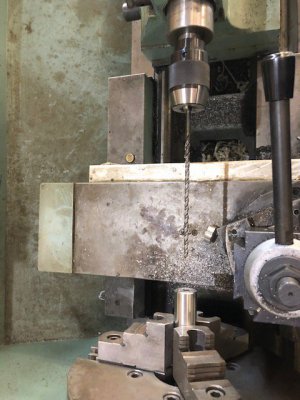
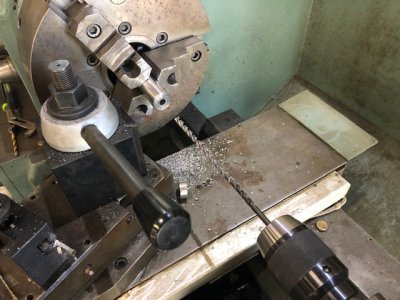
after longitudinal drilling, the shaft was set up in the bridgeport mill for the 5mm crossdrill operation.
i chamfered the grease holes
i added the M12 x 50mm stud and used red locktite to bond the stud.
here is the finished shaft copy, ready for retrofit !!!
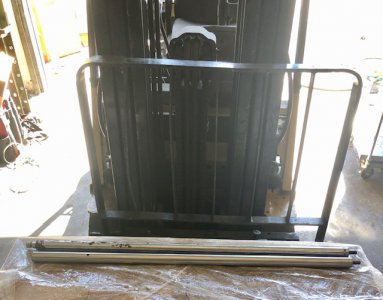
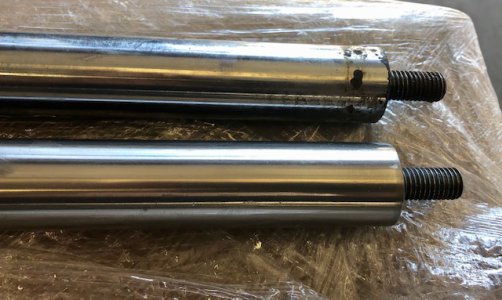
you can really see the cancer here below
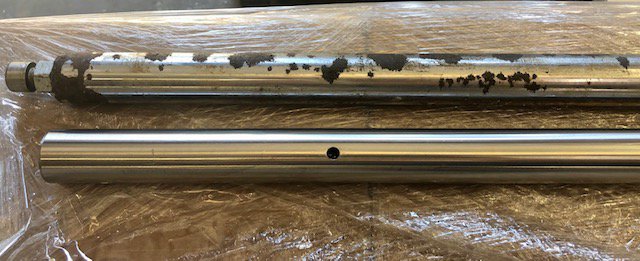

here is to another 20 years or so!
thanks for reading!!!
all of it is broken in one way or another.
my job is to put all the humpty dumpties' back together, ad infinitum.
this time i had a monkey wrench added.
The factory no longer supports parts for the industrial slicer i'm working on.
but, that doesn't mean its life is over- NOT ON MY WATCH !!!
I had to do the very same retrofit about a month ago.
i ordered the parts from the factory, using their infinite knowledge (read :sarcasm) to update the machine to current production.
they were very slow to send the parts from Germany ( 1 month lead) the parts were ridiculously expensive and the shaft was 100mm long.
i had to cut the shaft down and add the necessary features as i'll be doing today.........
this time, since i already had all the dimensions of all the parts i was to reproduce, i went around the factory completely.
the original production shaft was chrome plated steel.
they were well made and the shaft itself could last around 20 years, if strict lubrication guidelines were to be adhered.
in this case, lubrication only happened whenever i showed up- which was quarterly.
the machine was not maintained well, but somehow survived for 18 years-
until corrosion under the chrome started lifting and bubbling the chrome.
the shaft would physically lock up the moving member and stop operation due to overcurrent faults in the machine CPU
when they priced machine replacement,

i was soon the second call, to see if it could be resurrected



i told em' yep it can be fixed, but it is not going to be cheap or fast.
they begged for any help i could give.
so i put my very best foot forward and accepted the challenge!
the last retrofit revealed the factory used 303 stainless steel for the replacement shaft.
i followed suit and got a double length of the 30mm material, parting it into 2 equal final length parts of 900mm each
i drilled and tapped both ends to M12 x 1.25 x25 mm deep.
chamfered the ends
one end has a 6mm x 140mm deep bore, then cross drilled at 138mm from the end.
this is a grease track for lubrication of the shaft carriage
i had to use an extended length drill


after longitudinal drilling, the shaft was set up in the bridgeport mill for the 5mm crossdrill operation.
i chamfered the grease holes
i added the M12 x 50mm stud and used red locktite to bond the stud.
here is the finished shaft copy, ready for retrofit !!!


you can really see the cancer here below


here is to another 20 years or so!
thanks for reading!!!




